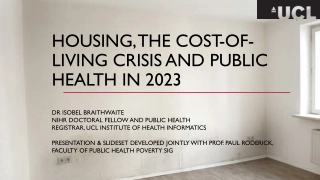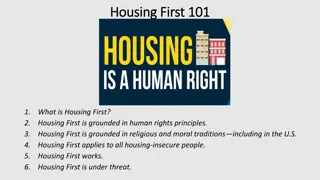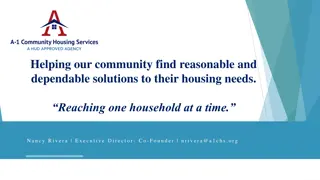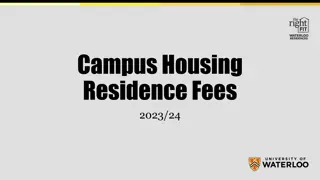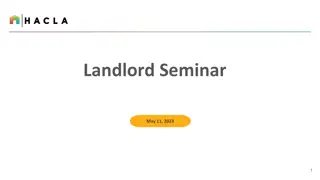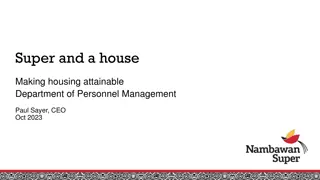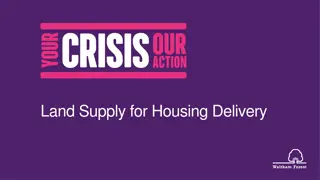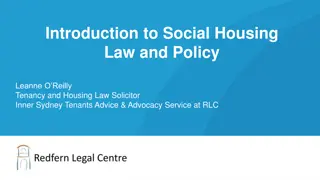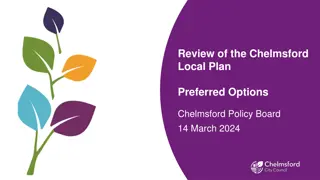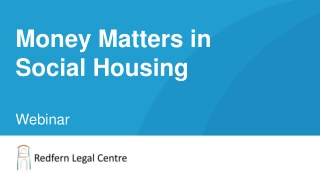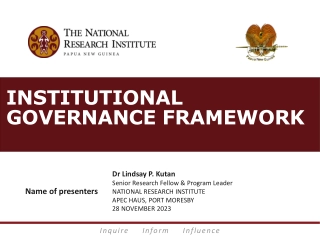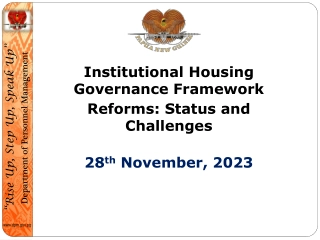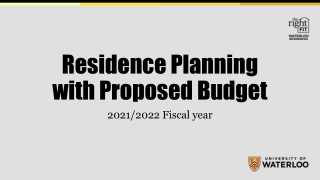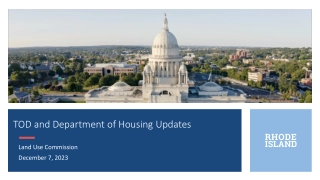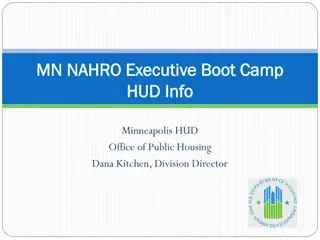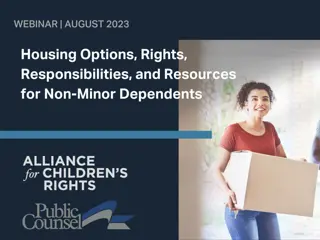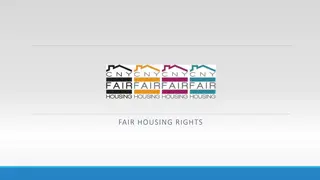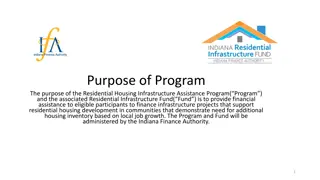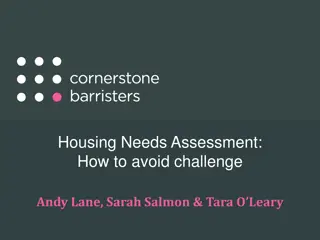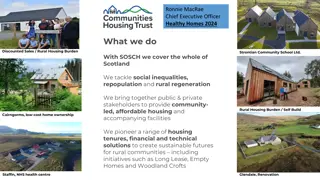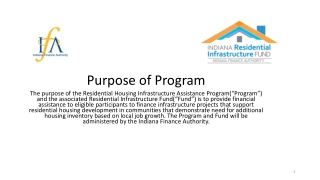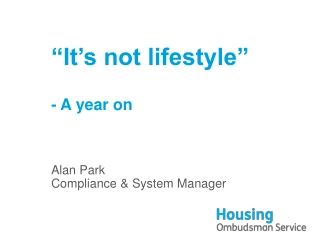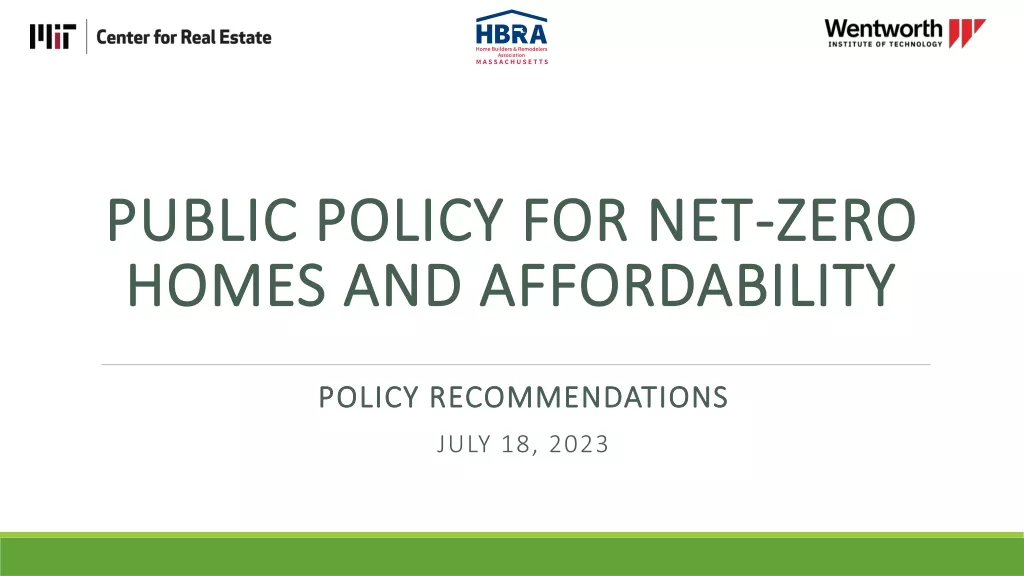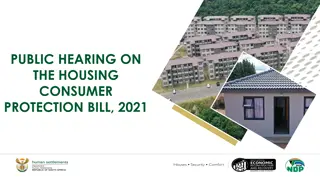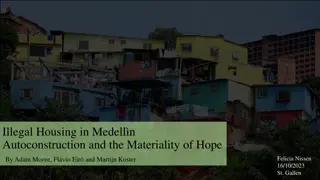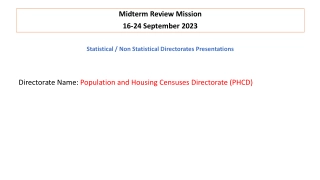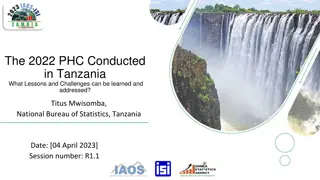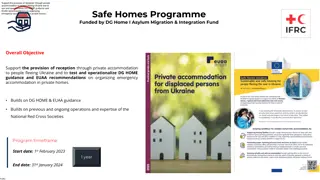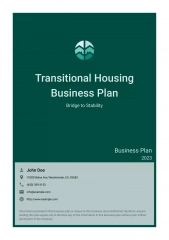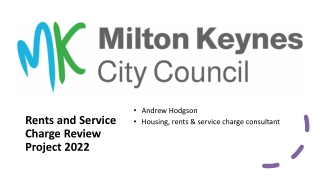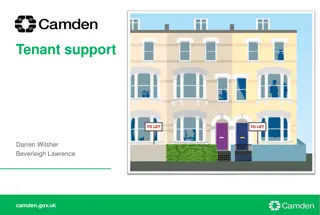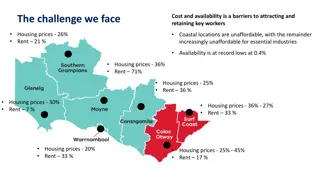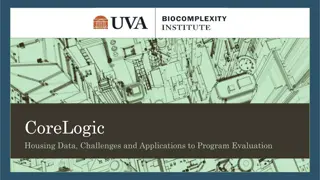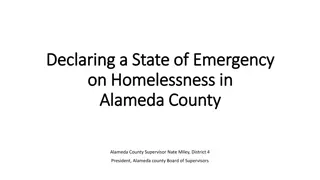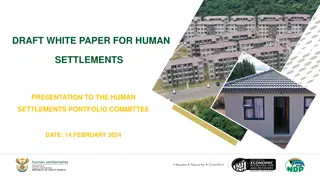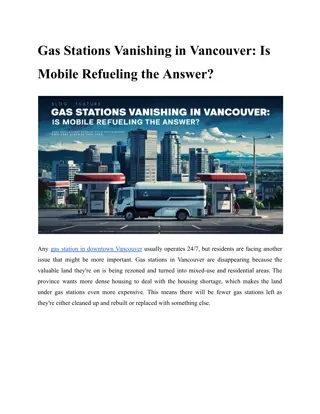Housing Needs Reorganisation
Providing conceptual models for a future Housing Needs structure, this document outlines options developed by Crisis Consultancy Service in collaboration with a local authority. The purpose is to initiate discussion, appraisal, testing, and decision-making, focusing on key accountabilities, customer journey, risks, and assumptions. Insights from a practice review highlight varying service models used by local authorities, emphasizing early intervention teams, specialist roles, outreach services, and landlord support strategies to prevent homelessness.
Housing Needs Reorganisation
PowerPoint presentation about 'Housing Needs Reorganisation'. This presentation describes the topic on Providing conceptual models for a future Housing Needs structure, this document outlines options developed by Crisis Consultancy Service in collaboration with a local authority. The purpose is to initiate discussion, appraisal, testing, and decision-making, focusing on key accountabilities, customer journey, risks, and assumptions. Insights from a practice review highlight varying service models used by local authorities, emphasizing early intervention teams, specialist roles, outreach services, and landlord support strategies to prevent homelessness.. Download this presentation absolutely free.
Presentation Transcript
Housing Needs Reorganisation Example options and proposals Crisis Consultancy Service
Purpose of this document Outline conceptual models for a future Housing Needs structure, developed by Crisis Consultancy Service working with a local authority. Provided options for discussion, appraisal against agreed principles, testing with officers and initial decision making & prioritisation. Purpose at this stage was not to get to the level of grading, role profiles, budgets etc. Options include: Visual functional model with key accountabilities/ capabilities Example high-level customer journey Supporting narrative with some key risks/ assumptions
Practice review Through our extensive work with local authorities across GB, Crisis have access to a wide range of practice evidence and experience from other local authorities. We have outlined here points from a practice review relating specifically to the service models and structures used by other local authorities. There is no "best practice model" or ideal way of setting up a statutory homelessness service functionally. Some LAs use triage models, generic officers, "split" models etc. to varying degrees of success. The structure is a facilitator of best practice but only one factor (alongside technology, staff, performance management etc.). The intention here is to provide some inspiration and common themes of good practice in this area: Early intervention/ outreach teams. Universal housing options advice and targeted early intervention (pre- 56 days). To identify at risk households (case finding) early and deliver integrated casework. Usually includes partner engagement/ upskilling/ coordinating to build community resilience, floating advice (embedding housing specialists in local community), dataspecialists to facilitate targeting, community navigators, universal support officers etc. Can be integrated across the council with Early Help services (housing navigators) and locality-based (e.g. North/ Central/ South) facilitating multi-disciplinary responses Above can include tenancy relations officers. Provide expert outreach advice and advocacy. Identify at-risk tenants of offending landlords and resolve tenancy disputes. Support, and where needed legal advocacy, can also be offered to mediate between landlords and tenants when problems arise Some Councils have extended this further to whole "Early Intervention Directorates" offering wraparound support across a number of issues Specialist roles/ teams around specific support needs e.g. drug and alcohol, mental health and employment. Welfare rights/ financial inclusion teams embedded in the homelessness service is increasingly common in LAs focusing on prevention driven by low incomes/ financial exclusion. Can include welfare, money management and debt advice
Practice review Teams/ functions for specific client types: most common are young people (16-25), single people under 35, single people with complex needs, families ('team around the family' approaches) Teams/ functions around specific interventions e.g. mediation, DHP Integrating services across housing, health and social care see Early Help example above, housing options staff in leaving care service, housing navigator in the MASH, integrated front door with Children s Services and Housing working together, multi-agency hubs (see below) Co-location of services with other statutory/ voluntary partners Landlord support service - Measures to build relationships with landlords in regard to their understanding of the risks to homelessness, opening access to the private rented sector, deposit schemes, and negotiating protocols for arrears and evictions. A service for landlords to solve issues before service of eviction notices. Provide support for both landlords and tenants with the aim of optimising prevention within the PRS. Can include other "market shaping" activity within the private rental market Tenancy sustainment teams Commonly commissioned. Floating support service for at risk tenancies or PRS placements. Some LAs co-locate with the prevention team Multi-agency hubs usually for singles or young people but Birmingham has the first "Domestic Abuse Home Options Hub". Some LAs attempting to create "Prevention Hubs" (jointly with partners) Business/ administrative support officers help deal with administrative burden of HRA, sometimes apprentices Accommodation finding service for all homeless customers gateway to various housing options in one place Digital provision e.g. AdviceAid, "digital front doors" etc. Split model: Prevention (Holistic, client-led casework) vs. Relief/ Main Duty (supported accommodation/ move on etc.) Peer mentors to help navigate the service "Lead caseworker" models or "Generic" i.e. same officer all the way through Link workers for risky transitions (see also colocation) - hospital, prison, asylum system etc.
Agreed core features of any future model More proactive triage team with more skilled/ experienced staff Parity in income/ pay between teams Closer integration with Adults + Children s Services young people, leaving care, families Clearly defined pathway for young people, domestic abuse and complex needs More tenancy sustainment provision/ emphasis More procurement officers and enhanced/ coordinated engagement with landlords and the private rented sector Every client (statutory homelessness) has a lead caseworker Reorientate service towards prevention, managing demand and trying to avoid main duty stage More models of partnership working (link workers, colocation, integrated services etc.) to facilitate multi-agency plans/ support Embedded administrative support and data/ insight capability Clear gateways to main accommodation and/ or support options Closer management and Quality Assurance of TA portfolio Dedicated team for arrears recovery Greater focus on assessing clients needs in TA and moving them to more cost-effective accommodation Greater focus on reducing the length of time households spend in TA Greater flexibility around roles within the service enabling officers to flex/ respond to fluctuating needs and demands on different parts of the service
MoSCoW Prioritisation (Draft) To facilitate prioritisation/ resourcing discussions Must Have . . The future structure/ model for the Housing Needs service guarantees to deliver these things to be fit for purpose and legally viable Should Have . . Important but not vital. Value/ benefits not realised if these things aren t included in future model. Ranked with highest priority first Could Have . . Wanted or desirable but less important and less impact if not included. Ranked with highest priority first More proactive triage team with more skilled/ experienced staff Roles focused on engaging and upskilling partners in preventing homelessness Colocation/ closer integration with Children s services Financial inclusion/ debt/ welfare specialists within the HN service Data analytics capability to find households at risk of homelessness Every client (statutory homelessness) has a lead caseworker Colocation/ closer integration with Mental health services and partners Colocation/ closer integration with Citizens Advice More tenancy sustainment provision/ emphasis Specialist tenancy relations officers within the HN service Colocation/ closer integration with Probation services More procurement officers and enhanced/ coordinated engagement with landlords and the private rented sector Specialist landlord negotiations/ mediators within the HN service Floating advice surgeries/ housing officers located in community locations Embedded administrative support and data/ insight capability Colocation/ closer integration with Adult social services Greater flexibility around roles within the service Specialist family mediators within the HN service Reconfigure roles to facilitate closer management & QA of TA portfolio; and reducing the length of time households spend in (costly) TA Colocation with Shelter Specialist mental health/ wellbeing officers within the HN service Prevention Hub supporting Triage+ and Lead Caseworkers
EHPS Core Service Option 1 Triage+ Landlord Support + Procurem ent Servic e Initial contact + assessment, process referrals, identify homeless applications, advice + information, interim placements Admin SA Referrals Commissioned Supported Accommodation Gateway to PRS. Build relati onships and liaise with landlords. Market shaping. S ustainmen t of PRS place ments. Gateway to supported accommodation SHPS Homelessness Caseworkers Single, non- priority prevention and relief casework Private Rented Sector/ Landlords Priority Prevention Hub prevention and relief casework Services to assist lead caseworkers in sustainable prevention of homelessness Rehousing/ Applications Admin H&C Sustainment Gateway to social housing Sustainment Admin Social Housing Allocations TA Booking Gateway to TA Gateway to social housing Mobility Interim/ Temporary Accommodation Sustainment Reception Centre Reception Centre Homeless Support H&C NPTA (PRS) Own Stock (Social) Specialist Support Arrears Recovery
Core Service Option 1: Narrative More proactive triage team with more skilled/ experienced staff and administrative support Lead caseworkers throughout customer journey providing SPOC, with administrative support Multi-agency portfolio of teams and services, data-led and over time responsive to trends in needs and demand Move-on work as soon as households go into TA (at relief stage) Coordinated gateway to options in the PRS, more procurement capability Greater emphasis and monitoring of sustainability of PRS placements Dedicated team for arrears recovery, closer QA of portfolio, greater emphasis on TA move- on
Core Service Option 1: Customer Journeys Pre-56 days/ Approach Initial Contact/ Assessment + Application Triage+ TA Booking (Accomm. Gateway) Inquiries + Assessment + PHP Prevention Hub Prevention Duty Homelessness Caseworkers Landlord Support + Procurement SHPS (Casework Support) TA Booking (Accomm. Gateway) (Lead (Lead Caseworker) Caseworker) SA Referrals Relief Duty HST/ RC/ H&C/ Specialist Support (TA Caseworker Relief Stage) (Lead Caseworker Main Duty) Rehousing/ Applications Allocations (Accommodat ion Gateways) Main Housing Duty Sustainment/ Post-Service SHPS (Lead Caseworker) Tenancy Sustainment (PRS/Social)
Key Assumptions Core Service Option 1 There will be tenancy sustainment capability/ capacity for all PRS placements made by the Council Every client will have a lead caseworker from SHPS or HC team during Prev/ Relief and from one of TA teams during main duty. Admin support and lead role in some cases, with suitable allocation and oversight, will keep caseloads manageable Higher graded and more skilled triage team will have the required training and capacity to manage some of the demand into the service Help first/ investigate second approach will lead to some people receiving help they are not legally entitled to Triage+ officers will liaise with TA booking to set up interim TA placements before cases picked up by lead caseworker. Will require mix of customer facing/ non-customer facing to provide time to do this, with appropriate checks and balances Procurement team will provide the main gateway and central route to access PRS properties. They will also manage strategic engagement with landlords. Early intervention work in the PRS will be picked up by other teams Key Risks Potential overlap for clients in interim accommodation during Relief stage will have lead caseworker and TA caseworker. Roles will need to be clear Continuity of support and emphasis on move-on when clients enter main duty stage No specialist team/support for the investigative elements of the role. May impact support element or force officers to prioritise one or the other if spread too thin and/ or cause a backlog in decisions Lack of accountability on others with lead workers, need to manage what happens when they are not there A more proactive front door leads to gatekeeping
EHPS Core Service Option 2 Triage+ Landlord Support + Procurem ent Servic e Initial contact + assessment, process referrals, identify homeless applications, advice + information, interim placements Admin SA Referrals Commissioned Supported Accommodation Gateway to PRS. Build relati onships and liaise with landlords. Market shaping. S ustainmen t of PRS place ments. Gateway to supported accommodation SHPS Homelessness Caseworkers Single, non- priority prevention and relief casework Private Rented Sector/ Landlords Priority Prevention Hub prevention and relief casework Services to assist lead caseworkers in sustainable prevention of homelessness Admin Admin Rehousing/ Applications Sustainment H&C Sustainment Inquiries + Decisions Main duty inquiries, decisions and discharge Gateway to social housing Social Housing Allocations TA Booking Gateway to TA Gateway to social housing Mobility Interim/ Temporary Accommodation Sustainment Reception Centre Reception Centre Homeless Support H&C NPTA (PRS) Own Stock (Social) Specialist Support Arrears Recovery
Core Service Option 2: Narrative Dedicated team for investigative vs. support elements of the caseworker role at end of relief/ Main Duty stage
Core Service Option 2: Customer Journeys Pre-56 days/ Approach Initial Contact/ Assessment + Application Triage+ TA Booking (Accomm. Gateway) Inquiries + Assessment + PHP Prevention Hub Prevention Duty Homelessness Caseworkers Landlord Support + Procurement SHPS (Casework Support) TA Booking (Accomm. Gateway) (Lead (Lead Caseworker) Caseworker) SA Referrals Relief Duty Rehousing/ Applications HST/ RC/ H&C/ Special ist Support (TA Caseworker Relief Stage) (Lead Caseworke r Main Duty) Allocations Inquiries + Decisions (Accommodat ion Gateways) Main Housing Duty Sustainment/ Post-Service SHPS (Lead Caseworker) Tenancy Sustainment (PRS/Social)
Core Service Option 2 Key Assumptions Inquiries + Decisions team will not be lead caseworkers. They will support relevant inquiries and decisions to notify and discharge the main housing duty the investigative element particularly around priority need, intentionality, local connection etc. Caseloads will be manageable The additional workload for this team (i.e. inquiries and decisions to be made) and the subsequent work it removes from the lead caseworkers to support clients (and develop empathic relationships) results in added value to the service and quicker decisions for customers Key Risks Additional team that will have contact with the client and make the process more complicated. Roles and accountabilities will need to be clear Continues to place high emphasis on decision making/ investigation? Less flexibility with more specialism e.g. sickness and leave within the I&D team Potentially less value if it is later in the process and haven t had the time to familiarise and understand client s situation If the homelessness caseworkers/ SHPS are picking up the H/TWH and eligibility decisions for prevention/ relief duties, is there a need for the team
Core Service Options: Prevention Hub Triage+ Informal Negotiation & Mediation New/ Change Current State Example Future State Prevention Hub HC/ SHPS Client Rough Sleeping/ SA Pathway (complex needs/ MD) Prevention Fund Complex Needs Floating Support Independent Futures, Leaving Care Service YPs (16-25) Floating Support Informal Negotiation & Mediation Support Need Domestic Abuse Landlord Support + Procurement Debt + Welfare Employment Intervention DHP/ Crisis Support Tenancy Sustainment/ Floating Support PRS Access Negotiation/ Mediation Landlord Negotiation/ Mediation F+F Internal council team Offending History Mental Health Specialist roles or teams (Housing Needs) Drug + Alcohol Single (under 35) Commissioned Range of support services for lead caseworkers and Triage+ to draw on. Mixture of in-house specialist roles/ teams and other agencies/ internal teams. Resourced appropriately to cover nature of demands on the service (cohorts, reasons for approach etc.) and support needs of households.
Core Service Options: Prevention Hub Key Assumptions SHPS/HC caseworkers will have base training in mediation & negotiation, with access to prevention funds and other forms of financial support Landlord Support + Procurement service will be the main gateway to find, access and match PRS properties Employment, crisis support and domestic abuse services used are currently fit for purpose in supporting the Housing Needs service Referrals need to be quick and easy Should be focused on things that can t be provided by homelessness caseworker role to sufficient skill/ capacity Key Risks Maintaining flexibility of the services and how they are delivered (in-house, partner, commissioned etc.) to respond appropriately to changing needs and demands of service users Unnecessary duplication
Core Service Options: Closer integration with Children's Current State Option: Housing Navigators Option: Integrated Front Door (or other services) Option: Multi-Agency Hub Early Help Housing + Children's Services Contact Team e.g. for young people (examples in Bristol, Greenwich, Birmingham etc.). See also dedicated pathways and models of partnership working Housing Navigator(s) Triage CSCT (inc. MASH) Single point of contact for all services for children, young people, and families who may need extra help and support; inc. those in housing need Targeted Youth Support/ YOS Joint assessment protocol (16/17 year olds) Housing Navigator Housing Needs Children s Services MASH Housing Navigator Independent Futures (Leaving Care Service) YPs (16-25) Floating Support (SHP) Supported Accommodation Housing Navigator Provides housing options and support services for 16-17 year olds, young people aged 18- 24 years and care leavers aged 18-24 who are at risk of homelessness, as part of an integrated youth service. Fully integrated one stop service led by Children s Services, in partnership with housing, health, and third sector providers Housing navigators located in key teams within Children's services. Role will vary depending on team but generally represent service by providing in-depth specialist housing help, navigating options, help accessing accommodation, upskilling CSC colleagues etc. Two departments work together to provide assessment, homelessness prevention and access to suitable accommodation. Children's services would need to take the lead on some elements and vice versa for others
Core Service Options: Closer integration with Children's Key Assumptions Home visiting, combined with the use of informal negotiation and mediation skills is highly effective when used consistently Mediation should be accessible, prior to crisis to help reduce tensions within the family. Local authorities should consistently offer services such as family mediation and/or counselling with options for these to be held in formal or informal settings. Key Risks
Core Service Options: Dedicated pathways (DA/ YP/ CN) St. Basils Positive Pathway Current State Option: Same route with 'generic' support Option: Unique and dedicated route Option: Same route with 'specialist' support for client group DA YP CN CN DA YP CN DA YP CN Triage+ 1. Universal Prev. 2. Early Help CN Hub Triage+ DA Hub YP Hub 1. Universal Prev. 2. Early Help SHPS Homelessness Caseworkers Specialist officers/ services e.g. family mediators, colocation with VAWG charity UP UP UP SHPS Homelessness Caseworkers EH EH EH 3. Crisis Prevention + Relief CP +R CP +R CP +R 3. Crisis Prevention + Relief Prevention Hub Prevention Hub Specialist officers/ services for client group inc. Integration with other teams (e.g. young people, family mediators etc.) Supported Housing Referrals Supported Housing Referrals Supported Housing Referrals 4. Commissioned Accommodation + Support 4. Commissioned Accommodation + Support 4. Commissioned Accommodation + Support Generic officers are trained in specific needs of key cohorts (e.g. DASH risk assessment) and customer journey is the same Broad customer journey is the same but specialisms located throughout journey to provide additional support to key cohorts e.g. NRPF service. Fully integrated one stop service with multiple agencies co-located Source: https://stbasils.org.uk/news/refreshed-positive-pathway-documents-launched/
Core Service Options: Dedicated pathways (DA/ YP/ CN) Key Assumptions Most DA approaches comes through council tenancies and Housing Tenancy Services dealt with outside of homelessness completely Refuges/ PRS via Solace referrals. Commissioned by VAWG service in Children s Key Risks
Core Service Options: Partnership working Option: Partner "Open- Access" + MA Casework Option: Colocation Option: MA Hubs/ Integrated Service Current State E.g. Youth Hub or Employment + Housing Support Service Partner Locations Lead Homelessness Caseworker Housing Navigators House hold PHP Triage+ Homelessness Caseworkers Partners Other Council Teams Prevention Hub External Partners Specialist Partner Partner Partners Either within partner locations or in the service. Will need to be agreed on a case by case basis. Those proposed so far include JCP, probation, hospitals, children s & adult s services Opening up the service and customer journey to partners main methods are via the PHP and case management system. Increased emphasis on multi-agency casework vs. just Housing Needs officers Specific teams or hubs with officers from the service and partners e.g. Pathway s model for hospital discharge
Core Service Options: Partnership working Key Assumptions The restructure and other accompanying service changes will continue to offer more opportunities for joint working with partners and see partners taking on more responsibility, regardless of the models or methods used Lead caseworkers will remain the SPOC from the Housing Needs service while a statutory duty is owed. Appropriate continuity of support where relevant will be agreed/ communicated to clients on discharge Data sharing issues can be resolved pragmatically Key partners are supportive of this Key Risks Will need to develop a more collaborative culture/ ethos within the service Council retains the legal duties so will need appropriate oversight/ quality assurance mechanisms agreed with partners
Additional option: Early intervention + outreach Current State Option: Dedicated EI + Outreach Team (Pre-56 Days) Option: Combination of both Option: EI + Outreach in Community EI + Outreach Community Locations Housing Specialists Universal Options + Advice Partner Engagement/ Upskilling Dedicated team which includes officers based in community locations Floating Advice Surgeries Identify At Risk Households (Data) Early Integrated Casework Community Navigators Tenancy Relations Officers Pre-Eviction + Arrears Protocols Option: Capabilities within Triage+ team Floating Support Early Mediation Early help services Locate some of these capabilities within the Triage+ function? Housing navigator(s) Range of capabilities that could be included in a dedicated team would include a mixture of proactive "case finding" and picking up cases that don't meet the crisis 56-day threshold. Should include close working with existing Early help services and key partners e.g. landlords Expanding the housing options service from one virtual/ physical location. Building community resilience and picking up cases early to avoid escalation to the 56-day threshold
Additional option: Early intervention + outreach Key Assumptions If they meet the threshold for statutory duty, client will have a lead worker from main service. Any pre-existing work started by EI+O team (e.g. mediation, floating support) could continue if appropriate; coordinated by lead worker during prevention/ relief duty stage The case finding work of the team will invariably identify more households needing support, but the value of earlier intervention and avoiding escalation will benefit the service over time The data capability within the team will enable proper evaluation, demonstrate the case for earlier intervention and evidence the number of homeless applications avoided/ demand reduced for the rest of the service Key Risks Additional handover point for clients working with EI + Outreach team who then meet statutory threshold Duplication between specialisms within the EI+O team and the Prevention Hub/ Triage+/ Lead Caseworkers. Will need to make sure it is clear who each is working with and when
Additional options Significantly enhanced digital provision inc. at 'front door' to the service Peer mentors to support clients through the service Dedicated commissioning/ contract management capability for the service Accommodation finding service one brokerage team to various accommodation gateways/ options




